The warhorse of the German army
No one at the Krupp factory in 1936 could have predicted that this massive model, equipped with a short barrel gun for infantry support, and considered at first as an auxiliary inside the Panzerdivisions, would be so extensively used in the German army. With nearly 9000 units (the real figures are still elusive), this was not only the biggest tank production in Germany ever, but it was also manufactured in growing numbers, despite the shortages, until the very last days of WW2 in Europe.
Despite a well-dated general conception, and the rise of the brand new generation of tanks that included the Panther, Tiger and Königstiger, it carried not only the bulk of the Wehrmacht, but was also the chosen tank for many elite SS Panzerdivisions. The recipe of this success was probably its large hull and turret, easy maintenance, reliability and a sturdy chassis, which allowed a more generous array of weapons than the Panzer III. From the Ausf.A to F1, the early “short” versions, using the short 75 mm (2.95 in) barrel, were gradually replaced by the “long” ones (F2 to H), using a very effective high velocity gun derived from the Pak 40, able to cope with the Russian T-34 and KV-1. They eventually completely replaced the Panzer III as the most numerous German battle tank.
Design of the Krupp prototype
 The initial specifications for the Panzer IV were set up in 1934 by the Waffenwamt, naming it a “Begleitwagen” or “accompanying vehicle”, to disguise its true role, then forbidden under the Versailles Treaty.
The initial specifications for the Panzer IV were set up in 1934 by the Waffenwamt, naming it a “Begleitwagen” or “accompanying vehicle”, to disguise its true role, then forbidden under the Versailles Treaty.
Right: The standard-issue Maybach 300 hp engine, which propelled both Panzer III and IV.
Heinz Guderian himself was behind the concept. This new model was meant to be a support tank for the infantry, placed on the rearguard of any Panzerdivision. One such unit would be available for every three spearheading companies of Panzer IIIs, at the tank battalion level. Contrary to the Panzer III, equipped with a variant of the standard-issue 37 mm (1.46 in) Pak 36, with good antitank capabilities, the short barrel howitzer of the Panzer IV was suitable against all kind of fortifications, blockhauses and pillboxes, or antitank guns and artillery positions.
At first, the allotted weight limit was 24 tons. Three prototypes were delivered by MAN, Krupp, and Rheinmetall-Borsig, and Krupp was awarded the main contract. The initial suspension was a brand new one, using six interleaved wheels. The army later required a torsion bar, giving better vertical deflection. This was proven to procure a smoother ride than the previous system, but the urge to develop the new tank prevented any further development. Krupp reverted to a more traditional system with four twin wheel bogies with leaf springs, permitting easier maintenance. The crew-size of five was allowed by the three-man turret, housing the commander, loader and gunner. The driver and radio operator/machine-gunner sat in the hull. The fighting compartment was relatively roomy and phonic isolation from the rear engine compartment was improved. The turret was fitted with intercom and radio. Although it was not apparent at first, the hull was asymmetrical, the turret being offset 6.5 cm (2.62 in) to the left, and the engine moved 15 cm (6 in) to the right. This was done in order to directly connect the turret ring to the main transmission torque shaft, allowing faster traverse. The ammunition lockers were subsequently placed on the roomier right side.
The Krupp prototype, designed and built in 1936 at Krupp AG’s factory in Magdeburg, was designated Versuchskraftfahrzeug 622 by the Waffenwamt. However, it quickly became known as the Pz.Kpfw. IV (Sd.Kfz.161) in the new prewar nomenclature. Its engine was the gasoline Maybach HL 108TR, developing 250 hp, with a SGR 75 transmission coupled with a five forward, one reverse gearbox. Maximum speed on trials (on flat ground) was 31 km/h (19 mph). The main gun was the 75 mm (2.95 in), low-velocity Kampfwagenkanone 37 L/24, or KwK 37 L/24. This gun was meant to deal with concrete fortifications using its HE shells. However, some antitank capacity was provided by the Panzergranate (AP shell), which reached 440 m/s (1450 ft/s). It was capable of penetrating 43 mm (1.7 in) of armor at 700 m (2300 ft). Two more MG 34s completed the armament, one coaxial and the other in the front hull plate. On the first production version, the Ausf.A, armor reached only 14.5 mm (0.57 in) on the hull and 20 mm (0.79 in) on the turret, although it was hardened steel. This protection was meant to deal only with light arms fire and light artillery and grenade fragments.

The early “short” pre-series: Ausf.A to D
The Ausf.A was a kind of pre-series, with only 35 units produced by 1936. The next step was the Ausf.B, with a modified commander cupola, a new Maybach HL 120TR engine, now developing 300 hp, and a new SSG75 transmission. Despite the additional weight, top speed was increased to 39 km/h (27 mph), and reinforced protection was issued. Armor was raised to 30 mm (1.18 in) on the frontal glacis, and 15 mm (0.59 in) elsewhere. The hull machine-gun was also protected by a new port. After a 42 unit run only, the production shifted to the Ausf.C. Armor was increased to 30 mm (1.18 in) around the turret. Total weight was now 18.15 tons. After 40 units were delivered by 1938, the type was improved by the introduction of the new Maybach HL 120TRM, for the next 100. Logically, the Ausf.D followed. The “Dora” was identified by the reintroduction of a hull machine gun, and the internal gun mantlet was now exteriorized. Side protection was also increased to 20 mm (0.79 in). 243 Ausf.D were built, the last being delivered in early 1940. The “D” was the last “pre-series”. Afterwards, it was decided to scale-up production.

Poster Panzer IV Ausf C, French campaign June 1940
Standardization with the Ausf.E
The Ausf.E was the first wartime large scale series. Although many studies and reports were published about the lack of penetrating power of the 37 mm (1.46 in) gun of the Panzer III, no gun upgrade was possible for it. In order to find a solution, a single Panzer IV Ausf.D prototype was fitted, for trials, with a derivative of the Pak 38, a medium velocity 50 mm (1.97 in) gun. The initial order for 80 units was dropped after the end of the French campaign. This had shown, definitively, the lack of protection and armor-piercing capabilities of German armor in tank-to-tank combat, notably against the British Matilda and French B1 bis. The Ausf.E kept the short KwK 37 L/24, but the front hull glacis was increased to 50 mm (1.97 in) of armor, with 30 mm (1.18 in) appliqué steel plates as an interim measure. The commander cupola was relocated further forward, and on late production vehicles a kit was provided for a large turret storage basket, in common with the Panzer III. Production reached 280 unit in April 1941, when this model was superseded by the Ausf.F.

The Ausf.F1, the last “short version”
The Ausf.F was a landmark in the Panzer IV evolution and development. The early model, “F”, called “F1” when the next model appeared, was the last of the “short” versions. The front bow plate appliqué was now replaced by a full 50 mm (1.97 in) thick armored plate. Side armor and turret thickness were raised to 30 mm (1.18 in). Total weight rose to more than 22 tons, which triggered other modifications, like larger track links (from 380 to 400 mm) to reduce ground pressure, and both the idler wheel and front drive sprockets were modified in turn. The F1 was produced to an extent of 464 units, until its replacement in March 1942. The last 42 were modified to the new F2 standard.
The Ausf.F2, the first “long”
Even equipped with the AP Panzergranate, the low-velocity gun of the Panzer IV was inadequate against well-armored tanks. In the context of the upcoming campaign in Russia, some decision had to be made, which also concerned the long-awaited major upgrade of the Panzer III. The now largely available Pak 38 L/60, which had been already proved lethal, was supposed to be mounted in the turret of the Panzer IV by Krupp. In November 1941, the prototype was ready, and production was scheduled to start on the F2 standard. But, with the first encounters of Russian KV-1s and T-34s, the 50 mm (1.97 in) gun, also produced for the Panzer III, was dropped in favor to a new, more powerful model, built by Rheinmetall, based on the 7.5 cm Pak 40 L/46 (2.95 in). This led to the KwK 40 L/43, a relatively long caliber gun, fitted with a muzzle-brake, which reduced its recoil. Muzzle velocity, with the Panzergranade 39, topped at 990 m/sec (3250 ft/sec). It could penetrate 77 mm (3.03 in) of armor up to 1850 m (6000 ft). After the first prototype was produced by Krupp, in February 1942, production of the F2 started. By July 1942, 175 had been delivered. However, in June 1942, the F2 was renamed Ausf.G, and further modifications were applied on the production line, but both types were known to the Waffenamt as the Sd.Kfz.161/1. Some nomenclatures and reports also speak of it as the F2/G version.
Scaled-up production
Production figures for the Panzer IV had been relatively small in size until 1942. From the Ausf.A to F2, only 1209 Panzer IVs (of the “short type”) had been delivered to the Wehrmacht. Subsequently, they served primarily in the infantry support role. However, the bulk of the production (around 7500) was spread in only three variants, The Ausf.G, H and J. These remained relatively unchanged until 1945, despite simplifications of the design. As the Panzer III‘s 50 mm (1.97 in) gun was not up to the task against the best Russian mediums and heavies, the main model, carrying the bulk of any Panzerdivision, became the Panzer IV. The former was progressively phased out, and replaced on the production line by cheaper SPGs, like the StuG III.
Panzer IV Ausf.G: The transitional model
The G was an improved F2, with armor modifications, including a weight saving solution, consisting of a progressive glacis side armor, thicker at the base. The frontal glacis received a new 30 mm (1.18 in) appliqué plate, giving a total of 80 mm (3.15 in). This was largely sufficient against the Russian medium-velocity 76 mm (3 in) gun and the fearful 76.2 mm anti-tank gun. At first, it was decided to bring only half production to this standard, but Adolf Hitler personally ordered, in January 1943, that the full production would be upgraded, a decision well-received by the crews. However, the weight rose to 23.6 tons, further stressing the limited capacity of the chassis and transmission. Both unit reports and mass-production requirements commanded further modifications. The turret vision port slits were eliminated, the engine ventilation and ignition at low temperatures were improved, and additional racks were fitted for spare road wheels and brackets for track links on the glacis. These acted as makeshift protection as well. A new headlight was installed and the commander cupola was up-armored and modified. The late production versions, in March-April 1943, saw the introduction of side skirt armor (Schürzen) to the sides and turret, the latter equipped with smoke grenade launchers. Most importantly, they received the new KwK 40 L/48, with greater penetration power. After 1275 had been delivered by Krupp-Gruson, Vomag and Nibelungenwerke, plus 412 of the upgunned type, the production shifted towards the Ausf.H.
Panzer IV Ausf.H: The main version
The Ausf.H was equipped with the new long caliber KwK 40 L/48, and was subsequently registered as the Sd.Kfz. 161/2 by the ordnance department. Other modifications included simplifications to ease production, like the removal of the hull side vision ports, and, later, part sharing with the Panzer III. This was by far the biggest production of the type, with a total of 3774 machines, until its replacement by the Ausf.J, in June 1944. Krupp had received a request, in December 1942, for a new version featuring all-sloped armor, which would have also required a new chassis, transmission and probably engine as well, due to the added weight. However, production started with an upgraded version of the Ausf.G instead. A new headlight was set, a new Zahnradfabrik ZF SSG-76 transmission, new set of radios (FU2 and 5, and intercom). This was necessary in order to cope with the full glacis protection raised to 80 mm (3.15 in), with no appliqué parts. The H now stood at 25 tons in battle order, and maximum speed fell to 38 km/h (24 mph), but only 25 km/h (16 mph) in real combat conditions, and far less on rough terrain. By the end of 1943, Zimmerit paste was factory-applied, new air filters were fitted, along with a turret anti-aircraft mount for an extra MG 34 (Fliegerbeschussgerat), as well as modifications to the commander cupola. Side and turret spaced armor was also factory-mounted.
Panzer IV Ausf.J: The late, simplified version

The last type, the Ausf.J, began to roll of the factory line at Nibelungenwerke (at St Valentin, Austria) and Vomag, as Krupp was now involved with other tasks, and incorporated more mass-production oriented simplifications, rarely welcomed by the crews. A first example was the removal of the electric turret drive, traversing being done manually, sacrificed for an additional 200 liters of fuel capacity, raising the operational range to 300 km (186 mi), a lesson hard learnt from the Russian campaign. Other modifications included the removal of the turret visor, pistol ports and turret AA mount in favor of a Naehverteidigungswaffe mount. Zimmerit was not applied anymore, nor was the Schurzen, replaced by cheaper Thoma type wire-mesh panels. The engine’s radiator housing was also simplified. The drive train lost one return roller, and two Flammentoeter (flame-suppressing) mufflers were installed, as well as Pilze 2-ton crane mount sockets. More critically, the late Panzer III SSG 77 transmission was mounted, despite it being clearly overloaded. Despite these sacrifices, the type J monthly deliveries were increasingly threatened by Allied bombings and the shortages caused, and only a total of 2970 were built until the last days of March 1945, Compare that to the total planned of 5,000, including modified models sporting the Panther turret. All prototypes developed by 1942 were dropped, in favor of the Panther. The chassis was also used for some variants.
Panzer IV variants
Jagdpanzer IV
Probably the best and most feared of these versions, this low and very efficient tank hunter was particularly at ease in Italy and Normandy. No less than 1980 were built in all, starting in 1943.
Sturmgeschütz IV
1140 of these excellent support assault tanks were quickly built, sporting the already proven Sturmgeschütz III superstructure and main armament.
Panzerbefehlswagen IV
The command version, equipped with a powerful set of radios, complete electrical equipment and corresponding wiring. These tanks were used to coordinate artillery support, infantry, as well as air support with Panzerdivisions. Roomy and dependable, it was probably the best German command tank of the war.
Panzerbeobachtungswagen IV
A well equipped artillery observation vehicle, working alongside with and coordinating Wespe and Hummel SPGs.
Sturmpanzer IV Brummbär
One of the most impressive German SPGs, the Brümmbar boasted a 150 mm (5.9 in) gun, and led to the Heuschrecke and Dicker Max prototypes.
Flakpanzer IV Möbelwagen
240 were built for AA support, with a single 37 mm (1.46 in) gun, produced in 1944-45, to compensate for the loss of air superiority, notably in Europe.
Flakpanzer IV Wirbelwind
Perhaps more famous, this AA support variant was equipped with the very effective quad 20 mm (0.79 in) Flakvierling. 100+ delivered. Using the same chassis and turret, 66 more were equipped with a single 37 mm gun (1.46 in), known as the Ostwind.
Geschützwagen III/IV Hummel
An artillery SPG built on a Panzer IV chassis and with Panzer III parts. Over 666 were built during the course of the war, and was one of the most successful German SPGs ever.
Panzerjäger III/IV Nashorn
A highly successful tank hunter, equipped with the legendary 88 mm (3.46 in) gun. It was less expensive than the Tiger. 473 were delivered overall.
Geschützwagen III/IV Schlepper
Using the same arrangement, 150 ammunition carriers were built.
Bergepanzer IV
A German ARV (Armored Recovery Vehicle), more powerful than previous versions based on the Panzer III. Mostly used on the Eastern Front. Perhaps 21 or 22 were converted using repaired tanks, without a turret and with a 2-ton crane supported with rigid towing bars. Modified amphibious Panzerfahre (2 prototypes) and Landwasserschlepper were also produced in limited quantities.
Bruckenleger IV
One of the earliest Panzer IV based variants, this was a bridgelayer vehicle. The unfolded bridge was 56 m (183 ft) long. 24 vehicles were produced prior to the campaign of France. 4 modified versions served in Russia with the 3rd Panzer Division, and 20 more with the 1st, 2nd, 3rd, 5th and 10th Panzer Divisions in May 1940.
With increasing losses, makeshift repairs, upgrades to new standards, and cannibalization of all kind of versions, it was difficult by late 1944 to distinguish the J from the H or even G types. Almost any tank was a sub-version in itself. When turretless variants were produced, many surplus turrets were used in armored trains, anti-tank rail cars or fixed concrete antitank positions.
Panzer IV conceptual variants
PzKpfw IV mit Schmalturm
This was intended to be the “final form” of the Panzer IV. It was an attempt to mount the Schmalturm “narrow-turret”, already under development for the Panther II project, on the chassis of a late model Panzer IV H. With the turret came a better gun. Specifically the 75 mm (2.95 in) L/70 tank gun from Rheinmetall. The project, having never left the drawing board, was cancelled as it was soon found that the Panzer IV chassis had hit it’s weight and modifiable limits.
Panzer IV mit Hydrostatischem Antrieb
In 1944 an attempt was made to install a Hydrostatic Drive into the Panzer IV. It gave hydraulic power to both the turret rotation mechanism and steering. The Drive was added into the rear of the tank, under a large sloping engine cover, culminating in 2 smaller drive wheels. Just one prototype was produced and was sent back to the United States after the war for assessment. The vehicle now sits in the US Army Museum, Maryland.
Flakpanzer IV Kugelblitz
The “Lightning Ball” was a late war prototype for a SPAA, intended to be a replacement for the Wirblewind and Ostwind models. It was one of the first tanks to feature a type of oscillating-turret, which was fully enclosed unlike most SPAAs of the era. This ball like turret was mounted with Zwillingsflak “twin-flak” 30mm MK 103 twin anti-aircraft cannons. These cannons fired at an impressive 450 rounds per-minute. A pilot run of 5 hulls and turrets to match is all that was produced by the time the war came to an end, but these were never mated.
Panzer IV operational history
With almost six full years of heavy fighting, from Poland to Berlin, September 1939 to May 1945, the battle records of the Panzer IV are indeed impressive. However, this is only when it was recognized as the staple of the German armored divisions and the mass-produced Ausf.G, H and J appeared, that the Panzer IV won its impressive battle records, in a largely fighting retreat, from the Eastern front to Africa. In comparison, the few “short barrel” versions only played a sideshow alongside the Panzer III, until the latter proved unsuitable for improvements. The Panzer IV could have been just a stopgap measure, giving way to the Panther and Tiger, if it was not for its moderate price (in comparison to the others), proven adaptability and reliability, easy maintenance, and large-scale adaptations of its chassis, which all powerfully contributed to a large increase to the scale of its deliveries until the end of the war.
From Poland to France (1939-1941)
At the very beginning, in September 1939, only a handful of these tanks were available, spread into each Panzerdivision, as only around 250 had been delivered so far. However, they were more numerous than the Panzer III. The 1st Panzer Division was the best equipped, other units having only 6 Panzer IVs and 5 Panzer IIIs for each battalion. They played their infantry support duties, dealing with fortifications and pockets of resistance. 675 tanks were lost in all during the conflict, mainly due to Polish anti-tank guns. Of a total of 2511 engaged, it was a higher price to pay than expected. Complaints about the armor quickly appeared, forwarded to the Waffenamt (Ordinance). The next production series saw mainly armor improvements, notably prior to the expected Western campaign. No Panzer IVs were shipped in Norway. However, when Fall Weiss was launched (invasion of France, Belgium and the Low Countries), according to Guderian, 278 were available. The slow rate of production made it the lesser type for all German AFVs. The 75 mm (2.95 in) gun using AP shells was efficient against most tanks, but not against the French B1, SOMUA, and the British Matilda II. But, despite limitations in armor and in armament, the good use of the radio, good training and excellent tactical coordination proved superior in all tank to tank engagements.
In Yugoslavia and Greece, there were perhaps 750 Panzer IVs available, although they were still in a minority compared to the Panzer III. Their dual-purpose gun proved invaluable on many occasions, although the terrain proved a serious limitation. They never encountered serious opposition, and the “short” series came to a close prior to Barbarossa, during the summer of 1941.
Russia and Africa (1942-1943)
The Panzer IV entered service with the Afrika Korps, namely the XVth Panzerdivision, 5th Light and XXIst Panzerdivision. As they were all short-barrel versions, they saw limited tank-to-tank engagements, still serving mostly as infantry support vehicles. They were eclipsed throughout 1941 by the 50 mm (1.97 in) equipped Panzer III. Only in August 1942 did Rommel receive 27 Ausf.F2s equipped with the long barrel gun, which had clear armor-piercing superiority over the Panzer III. They were generally placed at the tip of the spearheading forces, but they made little difference because of the clear material superiority of the British and Commonwealth Forces. However, in Tunisia, fresh reinforcement saw batches of Ausf.F2/Gs arriving in numbers, alongside a few Tigers. But even then, after some successes against US forces, Allied superiority began to tell. Most surviving heavy forces were reembarked and shipped to Sicily, where they were used in ambushes all along the road to Messina.
By the start of operation Barbarossa, in June 1941, the bulk of Panzer IV force was mobilized, spread into the many army groups and depleted Panzerdivisions that took part in the campaign. They were all of the “short” type. However, against many the encountered AFVs, mainly T-26s, T-28s and light tanks of the BT series, they proved efficient enough, until the prelude of the battle of Moscow, when the first mass assaults of KV-1s and T-34s began. By early 1942, the Panzer III’s main gun had proven inadequate, and the rearmament of the Panzer IV seemed to impose itself as the situation deteriorated. After some attempts with the 50 mm (1.97 in), the natural choice was to go with a longer 75 mm (2.95 in), the KwK 40 L43. Throughout 1942, production of the new types, F2 and G, increased for the needs of the Eastern front. Most Panzer IVs fielded during the summer offensive in the South were Ausf.F2s. They had a clear advantage over the T-34 and KV-1. Until May 1943, when the first Panthers and Tigers were introduced, they carried the bulk of the German Panzerdivisions.
When the battle of Kursk began, the Ausf.G and the first Hs were heavily engaged, many with Schurzen armor. This spaced type armor was meant to deal with infantry carried weapons and short range hollow charges. Alongside Tigers, Panthers (both plagued by reliability problems), StuGs and tank hunters, some 841 Panzer IVs were committed. The losses were appalling. At the end of the engagement, most divisions had only a handful of tanks left. In total, 2643 Panzers, the majority being Panzer IVs, were lost throughout 1943. Higher standardization allowed the Ausf.H to be mass-produced, which partly compensated for the losses, but not for the experienced crews. The most decorated of all, various Panzer regiments of the 4th Panzerdivision, had to withdraw to Poland to be reinforced, being reduced to a token force by the fall of 1943. In 1944, the simplified Ausf.J, easier to produce, was introduced, sporting the longer L48 caliber and new AP ammunition, which helped the Panzer IV, still the most numerous of all German tanks, to keep the superiority over Russian tanks. But this was not meant to last for long. By 1943, the new Russian T-34/85, SU-85 and SU-100 tanks hunters, and IS-1 and IS-2 were introduced, with high velocity guns, which outclassed the late J. It is estimated that a crippling 6153 Panzer IVs were lost on the Eastern Front, amounting to a 75% total of all deliveries.
France and Italy (1944-1945)
Compared to the strength of the units deployed on the Eastern front, the western European and Italian units were equipped with what was left of veteran units from Africa, makeshift units with heteroclite models, and fresh units with young and inexperienced, but well-trained crews. In Italy, Marshall Kesselring had just retreated successfully most of his precious armor from Sicily, themselves the surviving core of former Tunisian reinforcements and remnants of the Afrika Korps. With fresh reinforcements, comprising the first Panthers, and type H and J Panzer IVs, and later captured Italian vehicles. He strived to defend critical zones in the Gustav, and later Hitler lines, in mobile, small units, often commanded by elite tankers. During these years, from the fall of 1943 to early 1945, German tanks played a minor, but critical part alongside infantry, ambushing Allied forces while using at best a landscape which seemed to have been designed for defense. Tank to tank engagements were not rare, occurring notably against Canadian forces, massively equipped with the M4 Sherman. But many of the losses occurred through well placed antitank artillery positions and infantry weapons such as the Panzerfaust, first introduced then. In most engagements, the Panzer IV compensated for their lack of numbers by their high velocity long range gun, and a 80 mm (3.15 in) strong frontal armor.
In France, where Rommel came at Hitler’s personal request to organize the Atlantic wall defensive line, he saw a new reborn XVIth Panzerdivision, the former famous DAK unit. Also there were of a total of 11 Panzerdivisions, either from the well equipped SS units, or from the regular army (heer), all stationed in France and which took part to the Normandy campaign. Among these units, equipped with StuGs and Panthers, the Panzer IV accounted for half of their complement. Most were recent Ausf.H and J, factory-equipped with zimmerit and Schurzen spaced armor. The protracted Normandy campaign was once again a story of a terrain well suited for defense, with the famous hedgerows checkerboard landscape, a short-range terrain which favored ambushes and hit-and-run tactics. Well camouflaged, Panzer IVs, alongside StuGs and other tanks hunters, took a heavy tribute of US and Commonwealth AVFs before giving way, notably due to a total Allied air superiority, which prevented German efficient maneuvers by daylight. Their only viable opponent was a limited provision of Sherman Firefly tanks, equipped with the long 17 pdr (3 in/76.2 mm) gun, and, later on, the British Challenger. Around 750 Panzer IVs were engaged during this campaign, and most were lost in the process. Only the retreating Vth and VIIth Panzer Armies retained a handful of tanks.
Panzer IVs were also seen in action throughout the Low Countries, during the failed attempt to cross Germany’s northwestern frontier (operation Market Garden), and again in December 1944 in the Ardennes. Although they counted for half of the entire weight of the committed armored forces, propaganda only showed the most impressive, but few Tiger IIs. After this failed offensive, what was left of the Western Front armored might of the Werhmacht was reduced to tatters. From now on, Allied encounters with Panzer IVs were fortuitous ambushes at best. Allied tank superiority in 1945 was not only numerical, but qualitative also, with large provisions of tank hunters, and entirely equipped 17 pdr (76.2 mm/3 in) guns. The Panzer IV was also distributed among Axis allies and satellites, notably Bulgaria, which took deliveries of perhaps 400 of them, most of the late type, and retained the the survivors, alongside their T-34/85s, until 1989. Romania (T4 in local nomenclature), Hungary and, later, Italy also operated the Panzer IV in limited numbers. Finland bought 15 Ausf.Js in mid-1944, but the deliveries were out of schedule. They fought with the retreating German army in this sector.
Panzer IVs into the Cold War
It must be said that the large provision of surviving Panzer IV was not lost or scrapped, but saw service, like under Bulgarian colors in Europe, until 1989, or under Syrian colors in the Middle East. There, provisions of ex-French and ex-Spanish models were purchased, some equipped with a new Soviet 12.7 mm (0.5 in) heavy machine gun. They took part in the fight for the Golan Heights during the War of 1965, and the Six-Days War of 1967. Their opponents were much more recent Israeli Centurions and rearmed, upgraded Shermans. Some of them are part of the numerous machines still in existence in many museums and private collections around the globe, with perhaps a dozen in running condition.
Panzerkampfwagen IV production numbers and dates
Ausf A = 35 October 1937 – March 1938
Ausf B = 42 April 1938 – September 1938
Ausf C = 134 September 1938 – August 1939
Ausf D – 229 October 1939 – Mary 1941
Ausf E = 223 September 1940 – April 1941
Ausf F = 462 April 1941 – March 1942 (7.5cm Kpfwg.K. 37 L/24 gun)
Ausf F = 175+25 March 1942 – July 1942 (7.5cm Kpfwg.K. 40 L/43 gun)
Ausf G = 1687 May 1942 – June 1943
Ausf H = 3774 April 1943 – July 1944
Ausf J = 1758 June 1944 – March 1945
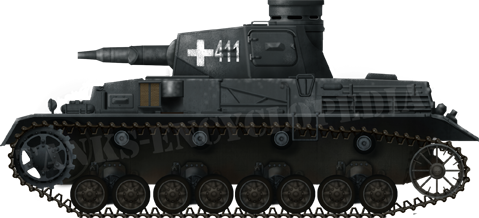
A Panzer IV Ausf.A, Poland, 4th Company, 1st Abteilung, 1st Panzer Regiment, 1st Panzerdivision.
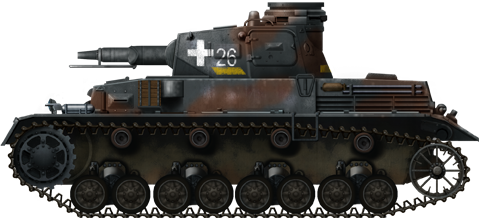
A Panzer IV Ausf.B, unknown unit, Poland, September 1939. Notice the classical makeshift camouflage, with a hastily sprayed reddish brown and yellow unit markings.
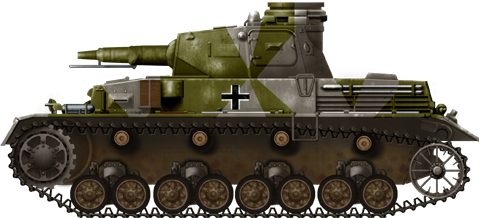
A Panzer IV Ausf.B of the 21st Panzerdivision – Normandy, June 1944.
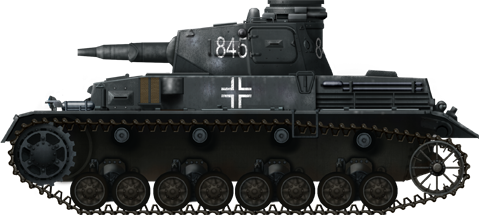
A Panzer IV Ausf.C, 8th Korps, IInd Abteilung, 35th Panzer Regiment, 4th Panzerdivision – France, May-June 1940.
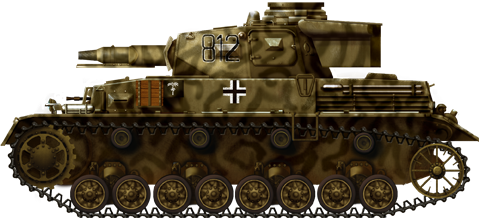
A Panzer IV Ausf.D, DAK (Deutsche Afrika Korps) of the XVth Panzerdivision, El Agheila, December 1941.
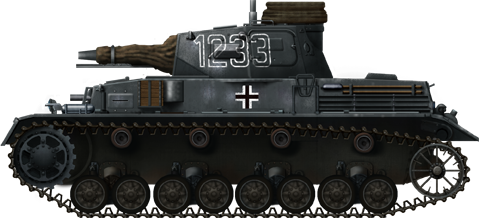
Tauchpanzer IV Ausf.D, provisioned for operation Seelöwe (or Sealion, prospected landings in Britain). It was theoretically capable of fording the Channel in shallow waters and sandbanks (6 to 15 meters/20-50 ft). Tests were also conducted with the Panzer III and II, but remained inconclusive. All apertures were carefully blocked and an auto-adaptive submarine type schnorchel mast was mounted on the turret, both for engine air feeding and exhaust. A total of 43 were converted by August-September 1940. Later on, 168 Panzer IIIs of various versions were also converted for Operation Barbarossa, to ford large rivers.
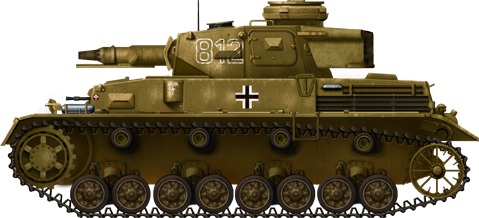
Panzer IV Ausf.E of the Afrika Korps, 15th Panzerdivision, Libya, the fall of 1941.
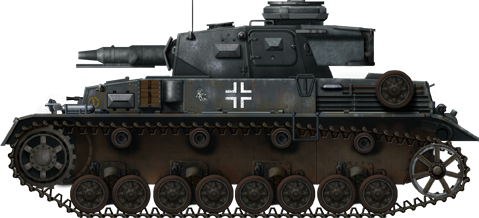
Panzer IV Ausf.E of the 11th Panzerdivision, April 1941, during the Yugoslavian campaign. Notice the bolted armor.

Panzer IV Ausf.F1 of the 5th Panzerdivision, Group Center, Russia, January 1942.
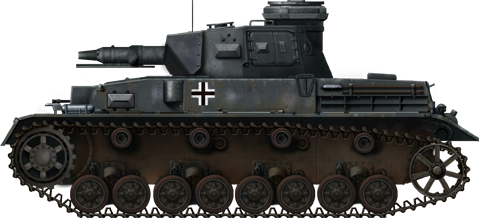
Vorpanzer F1, with extra bolted appliqué armor on the sides, gun mantlet and frontal glacis, with the 5th Panzerdivision, Group Center, Russia, winter 1941-1942.
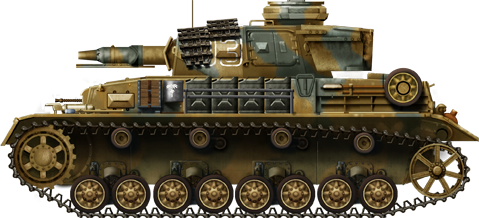
Panzer IV Ausf.F1 of the 5th Panzerregiment, 5th Leichtes Panzerdivision, Tobruk, Libya, March 1941. The camouflage was sand (Gelb braun) and degraded sand over the usual Dunkelgrau basis, forming Grau-Grün patches.
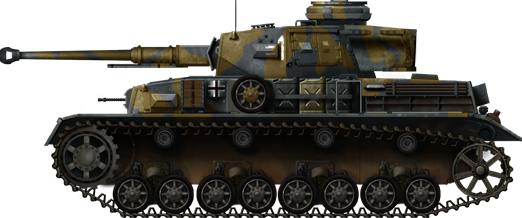
Panzer IV Ausf.F2/G of the 1st Infantry Division (motorized) “Grossdeutschland”, Voronezh, Russia, June 1942. Improvised pattern of sprayed brownish sand over standard factory dunkelgrau.
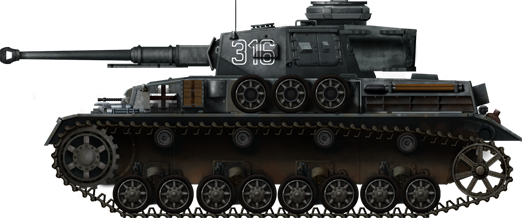
Ausf.F2, 1st SS Panzer battalion, SS Division LSSAH in France, which took part to “Case Anton” (invasion and occupation of Vichy French zone), November 1942.
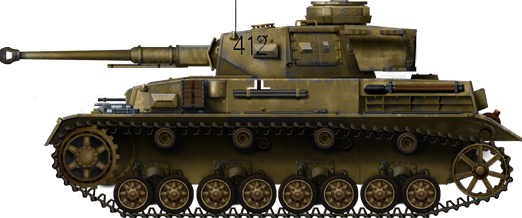
Ausf.F2, 4th Kompanie, 1st Abteilung, VIIIth Panzer-Regiment, XVth Panzerdivision, DAK, El Alamein (Egypt), October 1942.
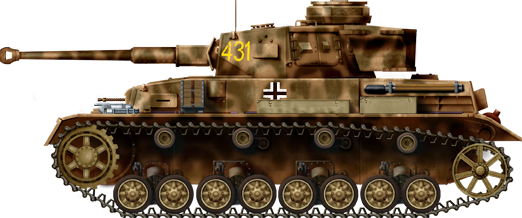
Ausf.F2, 36th Panzer Regiment, XIVth Panzerdivision, Army Group South, Russia, summer 1942.
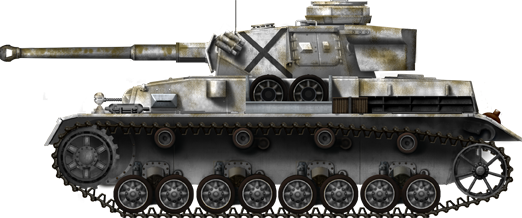
Bulgarian Maybach T4G (Ausf.F2/G), 13th unit, Russian border, winter 1942. Early production transitional model.
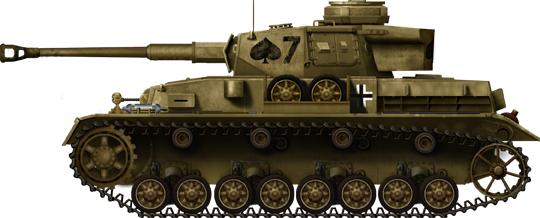
Ausf.G, XVth Panzerdivision, Tunisia, spring 1943. This is a late production vehicle, up-gunned with the new KwK 40 L/48 gun.
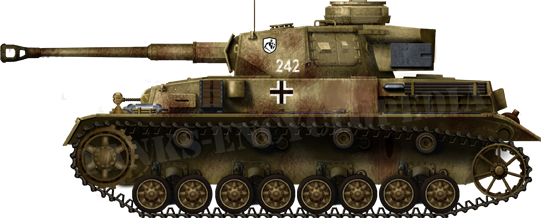
Panzer IV Ausf.G of the IVth Panzerdivision, battle of Orel, Russia, early 1943.
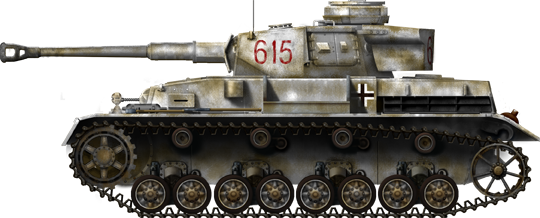
Panzer IV Ausf.G late production vehicle, XIVth Panzerdivision, Stalingrad, winter 1942/43.
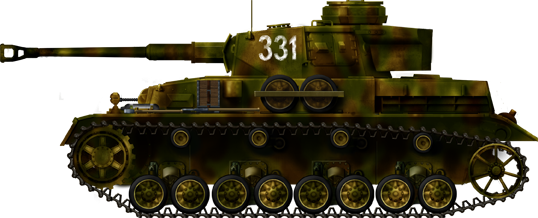
Panzer IV Ausf.G, XXth Panzer Division, Kursk, Russia, summer 1943.
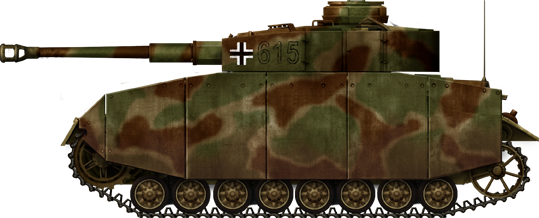
Ausf.F/G upgraded to the H standard, with full Schurzen armor – XVIth Panzerdivision, Russia, southern sector, summer 1943.
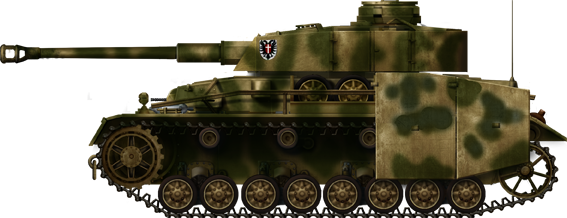
Ausf.H – XVIth Panzerdivision, Kursk, July 1943. The H were equipped with the new 7.5 cm Kampfwagenkanone 40 L48 (3.61 m/11.8 ft barrel) high velocity gun, along with the Pzgr.Patr.40 APCR, with a 990 m/sec muzzle velocity, capable of piercing 80 mm (3.15 in) of armor at 2000 m.
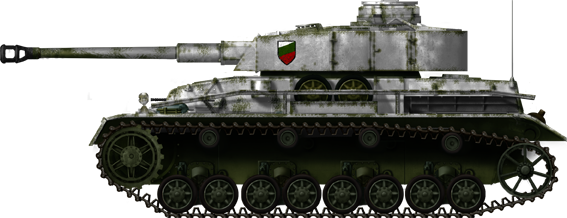
Panzer IV Ausf.H, 1st Armored Division, Bulgarian army, Hungary, winter 1944.
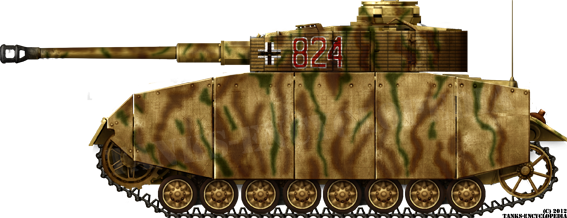
Ausf.H of the IInd Panzerdivision, France, June 1944.
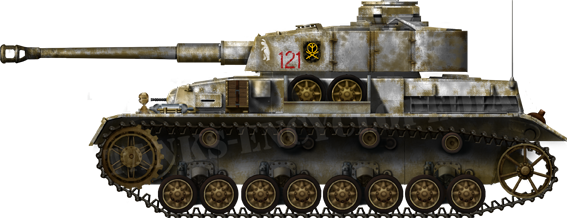
Ausf.H of the 35th Panzer Regiment of the IVrd Panzerdivision, Bobruysk, December 1943.
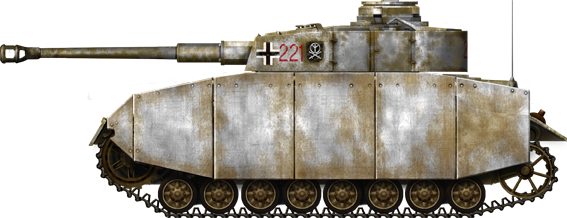
Ausf.H of the 35th Panzer Regiment of the IVth Panzerdivision, Kowel, Poland, early 1944. The 35th Regiment inflicted heavy losses on the Soviet 3rd Tank Corps at the Battle of Wołomin (part of operation Bagration). Its symbol was the “Grizlibär”, a menacing brown bear.
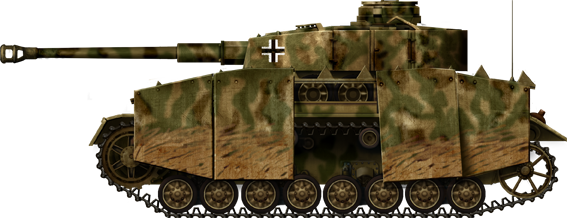
Panzer IV Ausf.H, IXth SS Panzer Division, France, summer 1944.
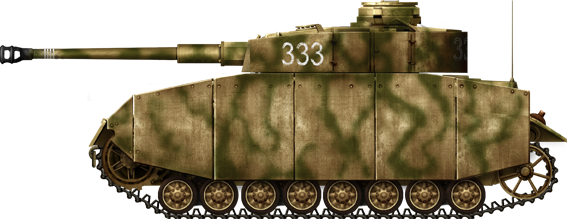
Panzer IV Ausf.H, 3rd Company, 130th Regiment of the 1st Panzerdivision, PanzerLehr, France, summer 1944.
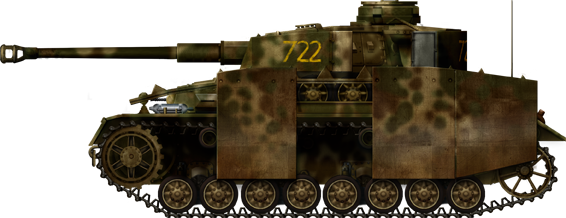
Ausf.H, 9th Panzerdivision, Central Germany, April 1945. Notice the “ambush” type spotted camouflage and turret Schurzen armor open panels.
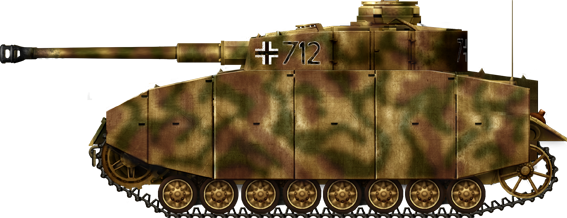
Panzer IV Ausf.H, 1st SS Panzerdivision Leibstandarte Adolf Hitler, France, summer 1944.
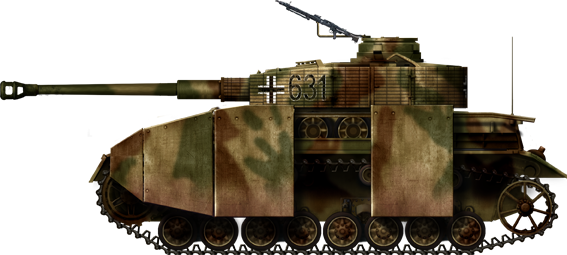
Ausf.J, 12th Panzerdivision SS “Hitlerjugend”, Normandy, France, June 1944.
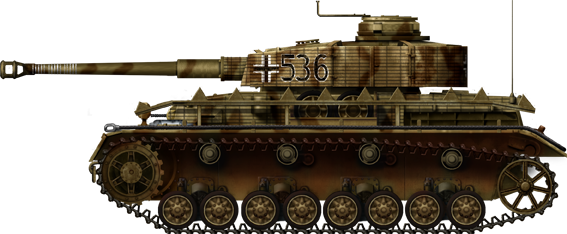
Panzer IV Ausf.J early production (unknown unit), Russia, summer 1944.
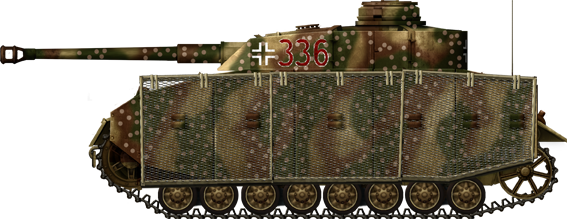
Panzer IV Ausf.J, central Germany, March 1945. Notice the wire-mesh side-skirts armor and complex “ambush pattern” camouflage.
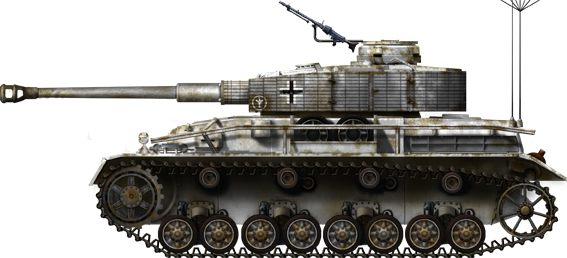
Ausf.J, 12th Panzerdivision, Northern Russia, early 1944. Notice the long range radio equipment and ring mount for an AA MG 34.
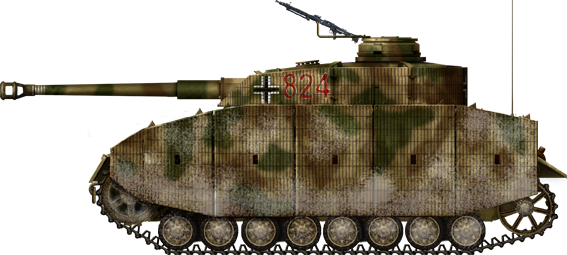
Panzer IV Ausf.J, IXth Panzerdivision, Ardennes, Belgium, December 1944. This is an early production model, with zimmerit on the entire hull and spaced armor.
History of the Panzer IV
Panzer IV Ausf.H specifications |
|
| Dimensions | 5.41 x 2.88 x 2.68 m (17.7×9.4×8.8 ft) |
| Total weight, battle ready | 25 tons |
| Crew | 5 |
| Armament | Rheinmetall 75 mm (2.95 in) KwK 40 2-3 MG 34/MG 42 7.92 mm (0.31 in) machine-guns |
| Armor | From 15 to 65 mm (0.59-2.56 in) |
| Propulsion | Maybach V12 gasoline HL 120 TRM (220 kW) 300 bhp@2500 rpm |
| Suspension | Leaf springs |
| Speed on /off road | 42/16 km/h (26/9.9 mph) |
| Range (road/off road) | 200 km (120 mi) |
| Total production | 8800 |
Links
en.wikipedia.org/wiki/Panzer_IV
achtungpanzer.com/panzerkampfwagen-iv.htm
Panzer Tracts No. 4-3 – Pz.Kpfw IV Ausf.H & J
Panzerkampfwagen IV Ausf.G, H and J 1942-45 (New Vanguard)

WW2 Tanks




























WW2 tanks posters

All Tiger tanks liveries.

Panther liveries and variants

WW2 Armour - All tanks











Tanks aces and single tanks series

Find more there

Museums, Movies, Books & Games
The Tanks and Armor in pop culture
Tanks and armored vehicles in general are only really grasped when seen first person: The mass, the scale, it's all there. Explore also the way tanks were covered in the movie industry, in books and in video games.Movies:
Best tanks movie on warhistoryonline.com
On imdb.com
On bestsimilar.com/
miltours.com
liveabout.com/
watchmojo.com
Video Games:
pcgamesn.com
historyhit.com
levvvel.com
vg247.com/best-tank-games
mmobomb.com/
alienwarearena.com


